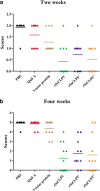A chitinase-like protein from Sarcoptes scabiei as a candidate anti-mite vaccine that contributes to immune protection in rabbits
- PMID: 30454025
- PMCID: PMC6245717
- DOI: 10.1186/s13071-018-3184-y
A chitinase-like protein from Sarcoptes scabiei as a candidate anti-mite vaccine that contributes to immune protection in rabbits
Abstract
Background: Scabies is caused by Sarcoptes scabiei burrowing into the stratum corneum of the host's skin and is detrimental to the health of humans and animals. Vaccines are an attractive alternative to replace the acaricides currently used in their control.
Methods: In the present study, the S. scabiei chitinase-like protein 5 (SsCLP5) was characterized and recombinant SsCLP5 (rSsCLP5) was evaluated as a candidate vaccine protein for anti-mite protection in rabbits. The expression, characterization and immunolocalization of SsCLP5 were examined. Vaccination experiments were performed on three test groups (n = 12 per group) immunized with purified rSsCLP5. Control groups (n = 12 per group) were immunized with PBS, QuilA saponin or empty vector protein. After challenge, the inflammatory reaction and skin lesions were graded and rSsCLP5 indirect ELISA was used to detect antibody IgG levels in serum samples at the time of vaccination and post-challenge.
Results: The results showed that rSsCLP5 had high immunoreactivity and immunogenicity. In S. scabiei, SsCLP5 had a wide distribution in the chewing mouthpart, legs and exoskeleton, especially the outer layer of the exoskeleton. Vaccination with rSsCLP5 resulted in 74.3% (26/35) of rabbits showing no detectable lesions after challenge with S. scabiei.
Conclusions: Our data demonstrate that rSsCLP5 is a promising candidate for a recombinant protein-based vaccine against S. scabiei. This study also provides a method for studying scabies vaccine using rabbit as an animal model and a basis for screening more effective candidate proteins.
Keywords: Chitinase-like protein 5; Recombinant protein; Sarcoptes scabiei; Scabies; Vaccine.
Conflict of interest statement
Ethics approval and consent to participate
All rabbits were handled in strict accordance with the animal protection laws of the People’s Republic of China (a draft of an animal protection law in China was released on September 18, 2009). All procedures were implemented in strict accordance with the Guide for the Care and Use of Laboratory Animals of the Animal Ethics Committee of Sichuan Agricultural University (Ya’an, China; approval no. 2013–028). All methods were carried out in accordance with relevant guidelines and regulations.
Consent for publication
Not applicable.
Competing interests
The authors declare that they have no competing interests.
Publisher’s Note
Springer Nature remains neutral with regard to jurisdictional claims in published maps and institutional affiliations.
Figures









Similar articles
-
Comparative analysis of the allergenic characteristics and serodiagnostic potential of recombinant chitinase-like protein-5 and -12 from Sarcoptes scabiei.Parasit Vectors. 2021 Mar 9;14(1):148. doi: 10.1186/s13071-021-04654-0. Parasit Vectors. 2021. PMID: 33750446 Free PMC article.
-
Vaccination of rabbits with immunodominant antigens from Sarcoptes scabiei induced high levels of humoral responses and pro-inflammatory cytokines but confers limited protection.Parasit Vectors. 2016 Aug 8;9(1):435. doi: 10.1186/s13071-016-1717-9. Parasit Vectors. 2016. PMID: 27502394 Free PMC article.
-
Vaccination with a cocktail vaccine elicits significant protection against Sarcoptes scabiei in rabbits, whereas the multi-epitope vaccine offers limited protection.Exp Parasitol. 2023 Feb;245:108442. doi: 10.1016/j.exppara.2022.108442. Epub 2022 Dec 9. Exp Parasitol. 2023. PMID: 36509170
-
Host immune responses to the itch mite, Sarcoptes scabiei, in humans.Parasit Vectors. 2017 Aug 10;10(1):385. doi: 10.1186/s13071-017-2320-4. Parasit Vectors. 2017. PMID: 28797273 Free PMC article. Review.
-
Vaccine against scabies: necessity and possibility.Parasitology. 2014 May;141(6):725-32. doi: 10.1017/S0031182013002047. Epub 2014 Jan 28. Parasitology. 2014. PMID: 24476932 Review.
Cited by
-
Comparative analysis of host resistance to Sarcoptes scabiei var. cuniculi in two different rabbit breeds.Parasit Vectors. 2019 Nov 8;12(1):530. doi: 10.1186/s13071-019-3764-5. Parasit Vectors. 2019. PMID: 31703721 Free PMC article.
-
Natural-Product-Based Solutions for Tropical Infectious Diseases.Clin Microbiol Rev. 2021 Dec 15;34(4):e0034820. doi: 10.1128/CMR.00348-20. Epub 2021 Sep 8. Clin Microbiol Rev. 2021. PMID: 34494873 Free PMC article. Review.
-
Laboratory-based diagnosis of scabies: a review of the current status.Trans R Soc Trop Med Hyg. 2022 Jan 19;116(1):4-9. doi: 10.1093/trstmh/trab049. Trans R Soc Trop Med Hyg. 2022. PMID: 33763705 Free PMC article. Review.
-
Mange in Rabbits: An Ectoparasitic Disease with a Zoonotic Potential.Vet Med Int. 2022 Jul 16;2022:5506272. doi: 10.1155/2022/5506272. eCollection 2022. Vet Med Int. 2022. PMID: 35880196 Free PMC article. Review.
-
Comparative analysis of the allergenic characteristics and serodiagnostic potential of recombinant chitinase-like protein-5 and -12 from Sarcoptes scabiei.Parasit Vectors. 2021 Mar 9;14(1):148. doi: 10.1186/s13071-021-04654-0. Parasit Vectors. 2021. PMID: 33750446 Free PMC article.
References
-
- Bornstein S, Mörner T, Samuel WM. Sarcoptes scabiei and sarcoptic mange. Des Moines: Iowa State University Press; 2008. pp. 107–119.
Publication types
MeSH terms
Substances
Grants and funding
LinkOut - more resources
Full Text Sources
Medical

